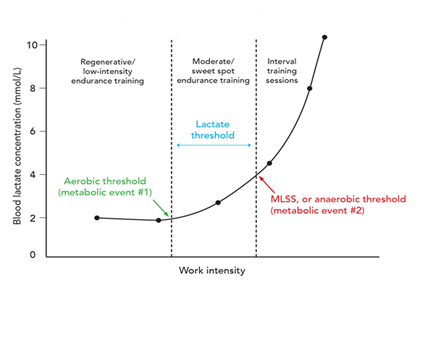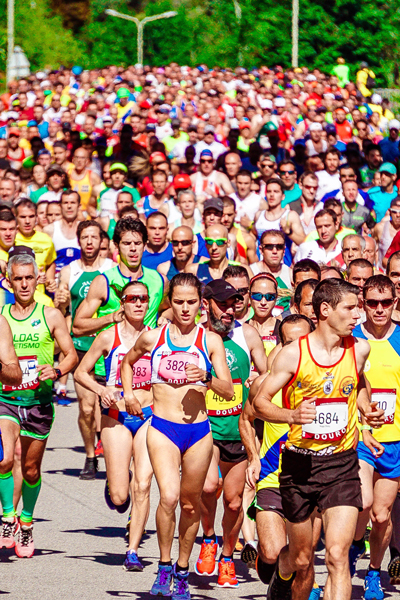From zero to hero!
Start 2 Run
As the word goes and has become wildly popular in recent years, you have to START somewhere if you want to jog/run.
Before taking your first jogging/running steps, it's best to start slowly with an alternation of walking and short runs. This way, you start right away with your first interval training as you alternate different intensities within one workout.
The importance here is not to overload the whole body from the first workout. Your body thus allows you to gradually get used to the new load that running entails. Each new workout here has the goal under the motto of progressive overload to progress step by step. Here we try by loading the body a little more each time than the previous time to keep aiming for progress.
Mostly at the start we aim to cope with the shock that walking brings to the body on the bones, tendons, joints and muscles.
When walking, you always have contact with the 2 feet on the ground at the same time so you always have support and balance from 2 points of support. This simultaneously ensures that there is never a floating moment in the air without contact and avoids the shock impact on the body that you do have when walking. When running, you always have only 1 foot and contact moment on the ground and a float phase in the air follows. This whipping phase is followed by an intense shock impact when the front foot catches the entire weight. This creates a huge overload on that side and can feel very intense if you are not used to this. The shock adds a very large additional impact that your body needs to get used to. The best way to do this is to gradually build up the number of shocks you have to deal with.
This provides the basis of all Start 2 Run schedules that alternate walking and jogging/running. More and more and/or longer blocks of jogging/walking are inserted into the program while the active rest periods during walking decrease. The goal is to build up to a 30-minute continuous walk after about 10-12 weeks with 3 workouts per week. You start with a complete time commitment of 20 minutes from the first workout with a 50/50 ratio of jogging/walking and walking. You slowly build up per workout and per week to the 30 minutes at 1 stretch jogging/walking without rest. Once you are here, you have the foundation to maintain a healthy lifestyle in which you can do short runs once or more per week to maintain/improve your cardiovascular health.
Cardiovascular workouts also have the advantage of burning a lot of kcal because of the continuous movement you do while exercising. This quickly burns several hundred kcal which also benefits your weight. Highly recommended for everyone!
Would you like support with this or do you need specific supportive coaching, feel free to contact us for advice or to do a basic fitness test to see where you start and/or stand at the beginning/completion of this startup.
.Start 2 Run More
Now that you've arrived at those first 30 minutes of running, your base load is good enough and you can continue training to do your first longer distance and/or maybe you're looking at a race?
.In order to train in a more focused way and get more results from your runs, we like to offer support with this. This by drawing up customized personal schedules and personal follow-up (depending on your choice weekly, biweekly or monthly). We do this by using the application of the market leader in the fitness world that we work with for the training & coaching story and monitoring your workouts.
Another factor in the cardiovascular story that becomes more important from this point forward is your own heart and its recording.
The reason that little to no attention is given here in the start-up phase of a start 2 run is the fact that the heart rate will always be too high to start training at heart rate already very focused. This is due to the strain that the heart receives from the new stimulus you give when starting to run. By training it several times a week, your heart will better meet the demand of energy for the running muscles by improved oxygen uptake from the air as well as circulating around the body by improving circulation to the running muscles. Your heart becomes stronger, works more efficiently and is better protected against heart disease. Your lungs follow the same pattern, thus start working better and protect you from respiratory diseases. Only benefits follow from cardiovascular workouts for everyone regardless of your age and training experience. Similarly, the removal of waste products from the muscles back into the air will improve and the body will work more efficiently with the energy there is in the body.
If we look at the energy used in the body during cardiovascular activities, we are at the macronutrients fat and carbohydrates. Both are used as sources to produce ATP (Adenosine Tri-Phosphate). ATP is the source of energy at the cellular level.
When fat is used to provide energy for cardiovascular activities to produce ATP, it is always by the addition of oxygen (O2). As a result, no lactate will be produced.
When carbohydrate/glucose is used to provide energy for cardiovascular activities to produce ATP, it can be done both by adding oxygen (O2), but also without!
When the energy demand -with more intensive running- becomes too great to meet the demand depending on the supply of oxygen through breathing, the body switches to providing energy from carbohydrates without oxygen. As a result, lactate will be produced.
Lactate (which is the acidic residue of lactic acid) is the end product from non-aerobic carbohydrate metabolism. It can itself be oxidized under the influence of oxygen via the citric acid cycle/creb cycle in cardiac muscle cells or even converted back to carbohydrate/glucose via the gluconeogenesis/Cori cycle.
Depending on the intensity of running, your body will get its energy for running from 3 different zones:
- Fats: via addition of sufficient oxygen – At low speeds
- Carbs: via addition of sufficient oxygen – Moderate speeds
- Carbs: without addition of oxygen – High speeds
Important to know is that fats are practically inexhaustible in our body and can provide endless energy for exertion. So, when we do cardiovascular workouts that rely solely on fats (taking into account that there is always a minimal/negligible amount of carbohydrates in the burn), we can run "unlimitedly", which is the basis for our fitness.
Carbohydrates, on the other hand, are limited in the body and can provide the energy we need for exercise.
Carbohydrates, on the other hand, are in limited supply in the body (stored in our muscles as muscle glycogen and in the liver, in addition to blood glucose circulating through the blood). As a result, we can do workouts at moderate speeds or high speeds only for a limited time depending on our supply of carbohydrates in the body at the time.
To know what these different speeds are for you at which you can best run as training, we can perfectly assess your current level through a fitness test and guide you to your level for your chosen route. Through a maximum effort test we look with you where your energy comes from to train optimally depending on your training and goal. By gradually increasing the speed during the test and looking at where your energy comes from at each step (based on blood lactate measurement), we know exactly where your training zones are. These zones are expressed in heart rate zones in which you can train because this is non-invasive and easy to use by using a heart rate monitor during training. This heart rate monitor indicates your heart rate and the associated energy delivery that we obtain from the test. Based on this, you can train more specifically in the different zones.
What zones are there and why should we train all of them depending on our goal:
Basic endurance/fat burning (Training Zone 1):
The zone in which you lay the foundation for your fitness, and thus the most important training zone, is the basic endurance zone. At an intensity of 60-80% of maximum heart rate, you practice fat burning/basic endurance/aerobic oxidation of fats. It is in this zone that primarily fats are burned using oxygen (=aerobic oxidation/energy delivery). Hardly any lactate is formed in this zone because the proportion of energy delivery from carbohydrates is very small. The fat threshold (also called the aerobic threshold/first physiological threshold) corresponds to the intensity at which fat burning is optimal and thus the best way to train to still be able to continue exercising intensively but for a long time. At this value, the greatest amount of fat is burned per unit of time. This zone lays the foundation for very long training sessions (5 hours and more 60-70%) and to train optimally in this zone, it is best to choose the high zone 70-80% of maximum heart rate for long endurance training sessions of 2h-4h.
Lactate suppression (Training Zone 2):
In this zone, the body energy demand per unit time is too high to rely solely on fats and, consequently, part of the energy will be obtained from carbohydrates. This results in a zone in which subjectively considerable effort is required of the athlete. It is in this zone that part of the energy occurs anaerobically (without oxygen addition). By creating the relatively high lactate levels in this zone, the athlete will learn to cope with these lactate levels, so the body will learn to create a lot of lactate. Training in this zone causes suppression of lactate production (Training Zone 3). These efforts are just below or at the carbohydrate threshold, also called skip pulse or anaerobic threshold as well as the second physiological threshold. The intensity of lactate suppression can be maintained for about 60 minutes around the turning point, depending on the amount of carbohydrates in your body and the exact location in this zone. This zone improves your sense of speed and prevents monotony during workouts since you are working at different speeds/tempo. To train in this zone, it is recommended to do interval training divided by relatively long blocks (5-20 minutes in zone 2) alternated with relatively short rest blocks in between (5 minutes - 2 minutes) in zone 1.
Lactate production/anaerobic zone (Training Zone 3):
In this highest intensity zone (also called resistance zone), the athlete can only perform this feat continuously for a few minutes. Only carbohydrates provide the fuel here, which are burned anaerobically. The effort here is approximately maximum and recovery after this workout can last 48h to 72h. Sprint training/maximal efforts are made to improve zone 3. This translates by alternating short intervals (15 seconds - 2 minutes) in zone 3 with rest blocks with a 1:3 to 1:6 ratio. Resting is done by staying in ZONE 1 / 2.

By knowing where your physiological thresholds lie, you can start training and preparing optimally for that new record distance or improvement of your previous peak performance. If you would like to know where your thresholds and heart rate zones lie, we will help you with a maximum effort test to map them out and provide you with advice for further training. Do you prefer a detailed training plan to follow based on your test then we are happy to provide this as well!
My sports watch shows 5 / 6 or 7 training zones?
Most sports watches and major sports industry brands usually indicate 5 - 7 training zones through their devices. This is based on the fact that they create subdivisions within the 3 physiological training zones discussed above. These subdivisions are intended to provide more training stimuli and prevent monotony in training, but do not detract from the fact that there are only 3 physiological training zones. Less is more ...
| Training Zone Watch/Sports Brand | Physiological Training Zone | Heart Rate Zone | Objective | Intensity |
|---|---|---|---|---|
| Zone 5 | Zone 3 | 90%-100% | Increase maximum performance and speed | Very heavy |
| Zone 4 | Zone 2 | 80%-90% | Increase performance capacity | Heavy |
| Zone 3 | Zone 1 | 70%-80% | Improving aerobic fitness | Average |
| Zone 2 | Zone 1 | 60%-70% | Fat burning/basic endurance | Light |
| Zone 1 | Zone 1 | 50%-60% | Minimal fat burning / Recovery training | Very light |








